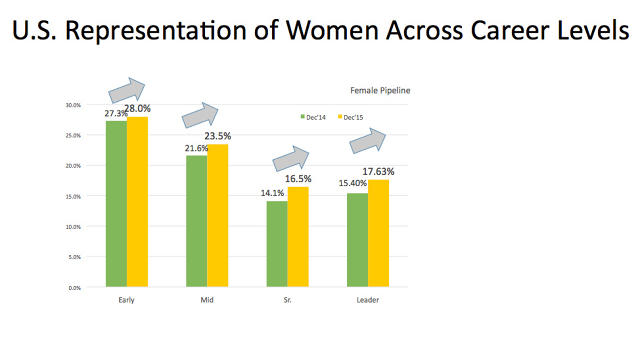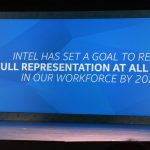Intel Has Made Some giant Steps towards Its range goals, So Why Are people Leaving?
Intel has made growth since it introduced its $300 million variety initiative final yr, but retention in some areas continues to be an issue.
February 3, 2016
It’s been a year considering Intel’s CEO Brian Krzanich announced a $300 million, 5-yr plan to carry the corporate’s staff to “full representation” by means of 2020. a few months ago, we reported that the company surpassed its hiring objectives for 2015.
In its ongoing effort to be radically clear in regards to the progress it can be making towards variety and inclusion in a lot of areas (no longer just hiring), Intel issued any other document on its first full year of outcomes. now not extraordinarily, the corporate is proud of the strides it can be already made for an funding of $fifty two.four million throughout the board in 2015.
What They’ve complete
general, Danielle Brown, Intel’s chief diversity and inclusion officer, referred to that the corporate has continued to hold every person of its greater than 107,000 employees accountable to its variety objectives through a company-extensive bonus software, a strong factor in figuring out the way it handed its hiring targets ultimate yr. in step with the file, the program yielded more than twice the number of referrals as within the previous year. Intel’s efforts to recruit a extra diverse group of workers also pushed into more colleges with greater range (a move we’ve reported can influence the quantity of black engineers at a company) and conferences.
Intel has additionally met its intention to maintain total various staff at the same fee as the remainder of the inhabitants, and is bumping both its hiring and retention targets for 2016.
the corporate also boosted representation of ladies via 5.4% in 2015, which now makes its whole female employee population stand at just about one quarter (24.8%). setting apart out the tech body of workers, women symbolize 20.1% (together with senior most important engineers), which is up 5.8% over the earlier 12 months. Intel’s senior management now stands at 17.6%. nonetheless low, however for all these women there is pay parity with their male counterparts. Brown notes that a compensation diagnosis introduced Intel to a hundred% pay parity in 2015.
To get there, Intel carried out a further compensation analysis analyzing gender pay parity for U.S. workers across job sorts and ranges, to make sure no person used to be getting paid not up to their job obligations dictated. This compares to the 23% pay hole in the total technology business, and the roughly 20% pay gap throughout the U.S., in keeping with the Bureau of Labor data. “In 2016, we’re intensifying our present efforts with superior audits, to conform to contemporary modifications in the laws of California and other states concerning pay fairness,” in step with the document.
“after all, we still have work to do,” Brown admitted in a teleconference.
What They still must Do
Most particularly, the corporate has simplest made slight improvements to rising the number of underrepresented minorities on body of workers (a complete of 0.1%, to finish the year at 12.four%), however fell in need of keeping underrepresented minorities. as an instance, African-American workers had a better exit fee than the rest of the body of workers. even supposing 209 had been hired, 201 (no longer necessarily the identical people) left the company. Eleven Native American employees have been hired, and 19 left ultimate 12 months. For comparison, last yr Intel employed 2,805 new staffers, and 3,364 left the corporate.
All this work to rent doesn’t mean a thing if Intel, or any company, can’t persuade its newest staff that they will really feel like they landed in an inclusive workplace.
Why are people leaving Intel? Brown tells quick firm that after all the prognosis on retention, “the explanations an employee chooses to remain or go away is very private.” therefore, she says, Intel can’t predict that there can be one overall approach to get folks to remain. “neighborhood building is necessary,” she says, like constructing a network of senior stage ladies who can make connections. “it is complicated,” she confesses.
Brown says that final year, Intel’s retention technique was once closely concerned about forming and building greater group amongst its numerous populations, and held many interior situations inquisitive about that intention. “That neighborhood constructing was useful, as a result of it helped give a boost to networks and create a sense of belonging and affinity,” she says. but it surely wasn’t all certain.
“The heavy center of attention on inner situations ended up pulling our diverse staff out of their day jobs too steadily, which didn’t set them up for superior success for progression and increase in their businesses,” Brown observes. Likewise, specializing in occasions for person communities did the alternative of fostering inclusion, she says, “as a result of we didn’t extend the events to include completely different, various perspectives past the workforce the event thinking about.”
The importance Of Inclusion
With over 107,000 employees in offices across the globe, subcultures are bound to sprout up. “Working as a technician in our labs could be very totally different than working as a marketing skilled in headquarters,” Brown says. “We take note we should tailor our techniques in retention and development and take into account the underlying, individual reasons staff keep or depart an organization, and what challenges they for my part face in retention and development,” she says.
On a companywide scale, Brown points out that while Intel has been conducting unconscious bias coaching for over a decade, that, too, wasn’t making so much of a dent in retention and development numbers. “we are nonetheless working on engineering bias out of our approaches,” she asserts, “but we wanted to do extra.”

Debora Bubb, Intel’s vice chairman of HR and its director of global leadership and finding out, chimes in to talk about develop, the company’s portal to a web page that comprises videos, research summaries, and apply instruments designed by way of neuroscientists and geared toward instructing staff how to progress of their careers in addition to tips on how to be extra inclusive.
staff who don’t stick round persistently cite reasons similar to feelings of isolation, a bad atmosphere, supervisor quality, or lack of skill to progress. Bubb says that grow is a “direct response to these subject matters.” She says grow engaged 25,000 employees in its first month, which coincided with the yr’s end and vacation trips.
“We’re already practicing new habits and integrating new language into our work and workforce interactions,” Bubb says. One is to easily keep in mind that to insert the phrase “but” on the finish of a sentence. That effectively adjustments a remark comparable to, “I’m not good at this,” to, “I’m no longer excellent at this yet.”
The neuroscience-primarily based curriculum is “an actual step forward in the strategy to retention and development,” in keeping with Brown.
Joelle Emerson, cofounder and CEO of the diversity and inclusion consultancy Paradigm, tells quick firm that because of the size of Intel, it might be onerous to now not most effective train 100% of staff about inclusivity, but also to inspire one hundred% of employees to vary their behaviors.
“however what we know from social science research is that well-designed interventions can also be remarkably impactful in altering individuals’s mind-sets and behaviors,” Emerson says. “for instance, within the space of “increase mind-set,” from which I believe Intel is hoping to draw, Stanford researchers found that brief interventions delivered online can make stronger learning and educational achievement throughout large our bodies of students,” notes Brown. “If Intel designs grow effectively, i believe there is a strong possibility that it is going to assist a majority of staff practice more inclusive conduct.”
How Twitter, facebook, Google, And different Silicon Valley Giants Can repair Their variety drawback:
quick company , learn Full Story
(48)














